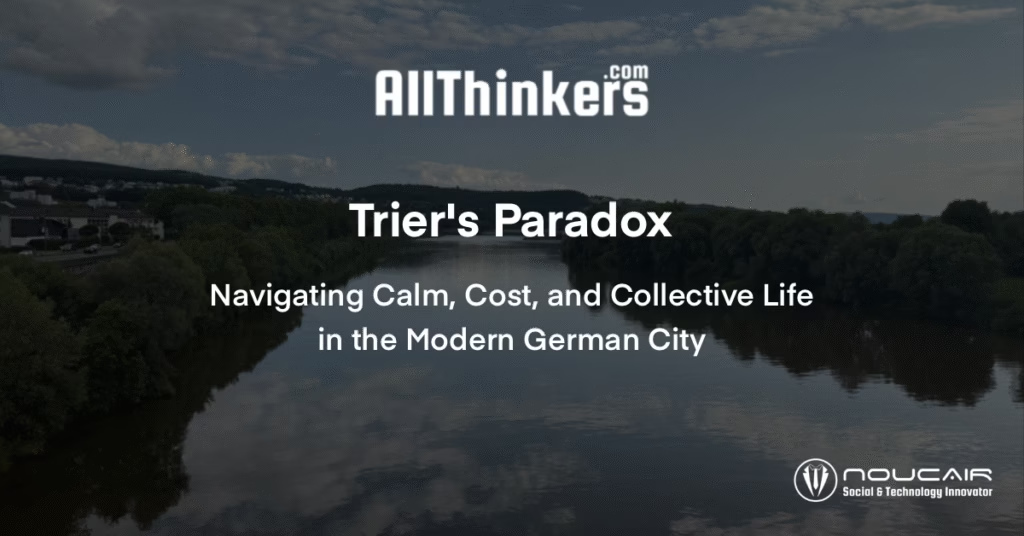The Subtle Rhythm of Urban Existence
Every city possesses a unique pulse—a rhythm shaped by its architecture, economy, and the daily lives of its inhabitants. As NOUCAIR B, a Visionary Innovator and CEO of AllThinkers.com and Andromedas.com, recently observed during a deep “global analysis” of Trier, Germany, this pulse can reveal profound insights into the delicate balance between order, well-being, and vitality. Trier presents a fascinating paradox: a city of profound calm conducive to deep thought, yet grappling with economic pressures and a social rhythm that invites reflection on modern urban living. This analysis offers critical perspectives for the AllThinkers Unified Theory, exploring how diverse urban dynamics shape True Intelligence and human potential.
1. Trier’s Tranquil Canvas: Cultivating Clarity in a Calm Environment
Your observation of Trier’s “too calm right now” atmosphere, coupled with “hot but clear sky,” is particularly compelling. You noted that this environment uniquely provides “an ability to concentrate and meditate that augment the clean thinking and the observation.” This highlights a crucial, often overlooked, dimension of urban design and its impact on human cognition.
A calm, uncluttered environment, free from sensory overload, directly supports “Depth” in thinking – a vital component of True Intelligence (IT=Speed×Depth). Such conditions foster focused work, introspection, and enhanced observational capacity, allowing for deeper insights. This suggests that the very quietude of certain urban spaces can be a powerful asset for intellectual productivity and mental well-being.
2. The Economic Equation: Prosperity, Prices, and the Housing Imperative
However, beneath this tranquil surface, Trier, like much of Germany, navigates a complex economic reality. You noted that prices in major markets like DM, LIDL, Wasgau, Aldi, and Kaufland are “expensive compared to last years,” and that dining at SUBWAY, coffee shops, and many restaurants is “too expensive.” This rising cost of living creates palpable pressure.
Yet, you also observed that citizens, benefiting from elevated salaries, “has potential to buy.” This implies a fascinating economic dance where increased earning power meets a rising cost of goods and services. Amidst this, you pinpointed a critical challenge: “the location are difficult to find a house and this is the biggest problem in Germany also, they most find a solution.” This housing crisis is a pervasive issue, impacting quality of life, economic mobility, and the ability to attract and retain talent in a region. While “GAZ is expensive in the stations,” the presence of “a free highway gives an equal equation,” and “the infrastructure are good also that very important,” providing some balance in the logistical aspects of daily life.
3. The Social Rhythm: Order, Solitude, and the Quest for Activity
Perhaps the most poignant observation from your analysis touches upon Trier’s social fabric: “the citizens are calm but like robot every one goes alone, and at 21 every things close (the shut down start) to an other work day… this is the routine I guess in German, and without activity still difficult to live and continue.”
This description paints a picture of a highly ordered, efficient society where individual autonomy and routine are paramount. While this structure contributes to the aforementioned calm and order, it also raises questions about its impact on collective vitality and spontaneous human connection. The “every one goes alone” and early “shut down” can potentially limit opportunities for social engagement, community building, and the kind of vibrant collective experiences witnessed in Luxembourg’s National Day celebrations. This tension between structured calm and the human need for activity and spontaneous connection directly impacts the “Emotion” and “Ethics” dimensions of Human 8D, highlighting a challenge in fostering holistic well-being beyond mere efficiency.
4. AllThinkers’ Lens: Innovating for Balanced Urban Futures
Your “global analysis” of Trier provides invaluable insights for the AllThinkers community. These observations are not just critiques but fertile ground for multidisciplinary problem-solving:
- Holistic Urban Design: How can cities, particularly those with a strong emphasis on order and efficiency like Trier, introduce elements that foster community interaction and spontaneous activity without sacrificing valued calm? This involves intelligent urban planning, adaptable public spaces, and community-driven initiatives.
- Addressing Socio-Economic Challenges: The housing crisis, for instance, requires innovative solutions that balance market forces with social equity. This is a prime area for social innovation, inviting collective intelligence from our community to propose sustainable and human-centric solutions. (We look forward to your propositions on this, Noucair!)
- Balancing “Speed” with “Depth” in Daily Life: While German infrastructure and routine contribute to societal “Speed,” the challenge lies in ensuring that this efficiency does not inadvertently limit the “Depth” of human experience—the emotional connections, spontaneous joys, and diverse activities crucial for overall well-being and a richer Collective Intelligence.
- Leveraging Digital for Social Vitality: How can digital platforms complement physical urban spaces? In environments where physical interactions may be limited after 9 PM, technology can bridge gaps, fostering online communities, virtual events, or local digital hubs that encourage connection and shared “activity,” transforming the “shut down” into an opportunity for new forms of engagement.
Conclusion: Designing for Human Flourishing in Structured Worlds
Trier, with its unique blend of tranquil efficiency and underlying social and economic complexities, serves as a powerful case study for the modern urban condition. It underscores that truly intelligent cities are not just productive; they are designed to foster holistic human flourishing. Through the multidisciplinary lens of AllThinkers, by analyzing such nuanced observations and applying True Intelligence that balances “Speed” with “Depth,” we can envision and build urban futures that are both efficient and vibrantly human, addressing challenges and unlocking the full potential of every citizen.


